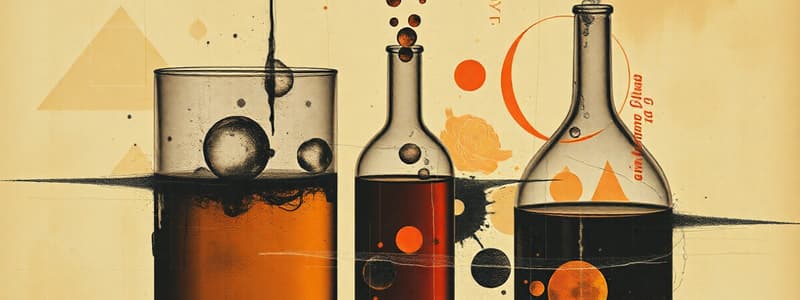Podcast
Questions and Answers
Which of the following best describes the initial stage of solid dissolution in a liquid?
Which of the following best describes the initial stage of solid dissolution in a liquid?
- The rapid movement of the solid particles throughout the liquid.
- The formation of a saturated solution with undissolved solid.
- The wetting of the solid surface by the liquid, followed by particle separation. (correct)
- The immediate diffusion of the solid molecules into the liquid matrix.
What is the most likely consequence of adding more solid to a solution that is already at its solubility limit?
What is the most likely consequence of adding more solid to a solution that is already at its solubility limit?
- It will result in a supersaturated solution, with the solid remaining in solution.
- The excess solid will convert to a liquid state via a phase change.
- The added solid will remain undissolved, forming a separate solid phase. (correct)
- The excess solid will dissolve into the solution, increasing its concentration.
Which of the following best characterizes a semi-polar solvent?
Which of the following best characterizes a semi-polar solvent?
- It can dissolve both polar and nonpolar substances to a limited degree. (correct)
- It lacks the ability to dissolve any ionic compounds.
- It can only dissolve nonpolar compounds, failing to form hydrogen bonds.
- It is composed solely of molecules with highly symmetric charge distribution.
Which of these pharmaceutical processes is least likely to involve diffusion?
Which of these pharmaceutical processes is least likely to involve diffusion?
For molecular diffusion through a nonporous matrix, which factor is most important?
For molecular diffusion through a nonporous matrix, which factor is most important?
Which of these is most likely the determining factor for diffusion through a solvent-filled pore?
Which of these is most likely the determining factor for diffusion through a solvent-filled pore?
In a polymeric membrane with overlapping strands forming tortuous channels, how do diffusants primarily move?
In a polymeric membrane with overlapping strands forming tortuous channels, how do diffusants primarily move?
According to Fick's First Law of Diffusion, if the concentration gradient becomes zero, the flux will:
According to Fick's First Law of Diffusion, if the concentration gradient becomes zero, the flux will:
Flashcards
Dissolution
Dissolution
The process where a solid substance dissolves into a liquid, forming a solution. It involves two stages: 1) Dispersion: The solid breaks down into smaller particles. 2) Solvation: The individual particles are surrounded by solvent molecules.
Solubility
Solubility
The maximum amount of a solute that can dissolve in a given amount of solvent at a specific temperature. It's a measure of how much solute can be added to a solution before it becomes saturated.
Saturated solution
Saturated solution
A solution that contains the maximum amount of solute that can be dissolved at a given temperature. Adding more solute will result in undissolved solid.
Diffusion
Diffusion
Signup and view all the flashcards
Diffusion through solvent-filled pores
Diffusion through solvent-filled pores
Signup and view all the flashcards
Diffusion through nonporous media
Diffusion through nonporous media
Signup and view all the flashcards
Fick's first law of diffusion
Fick's first law of diffusion
Signup and view all the flashcards
Diffusion coefficient (D)
Diffusion coefficient (D)
Signup and view all the flashcards
Study Notes
Dissolution, Solubility, and Diffusion
-
Dissolution: Defined as the process of a solid dissolving in a liquid, having two stages:
- Stage 1: The solid dissolves to form solute particles.
- Stage 2: These solute particles become dispersed throughout the liquid solvent.
-
Solubility and Miscibility:
- Solubility is the maximum amount of solute that can dissolve in a given amount of solvent at a specific temperature and pressure.
- Miscibility refers to the ability of two liquids to mix together in any proportion.
- A solution beyond solubility limit results in precipitation
-
Solvent Classification: Solvents are categorized as polar, semipolar, or nonpolar based on their intermolecular forces.
-
Diffusion: Defined as the net movement of particles from an area of high concentration to an area of low concentration.
- It can be a relatively fast or slow process depending on the medium and factors like temperature.
- Pharmaceutical applications involving diffusion are numerous.
-
Diffusion Through Solid Barriers: Diffusion can occur through a solid barrier by simple molecular diffusion or by movement through solvent-filled pores or both.
-
Diffusion Through Nonporous Media:
- Diffusion through nonporous media depends on the permeating molecules' solubility in the bulk membrane.
- The statement "The diffusion of a drug through a polymeric membrane involves dissolution of the drug in the matrix of the membrane" is debatable/requiring further clarification.
-
Diffusion Through Solvent-Filled Pores: Diffusion through solvent-filled pores is mainly affected by the relative size of the penetrating molecules and the pore diameter/shape.
-
Diffusion Through Membranes with Polymeric Strands:
- Molecules can diffuse through tortuous pores formed due to overlapping polymer strands, OR dissolve in the polymer matrix.
-
Biological Membrane Diffusion:
- Methods include: transcellular and paracellular diffusion, and using membrane transporters.
-
Fick's First Law of Diffusion:
- Describes the relationship between diffusion flux, concentration gradient, and diffusion coefficient.
- Diffusion stops when a concentration equilibrium is reached (no net movement)
- A negative sign appears in Fick's Law equation because diffusion occurs down the concentration gradient.
- Several factors like temperature, size of diffusing particles, medium properties and others affect the diffusion coefficient values.
Studying That Suits You
Use AI to generate personalized quizzes and flashcards to suit your learning preferences.



